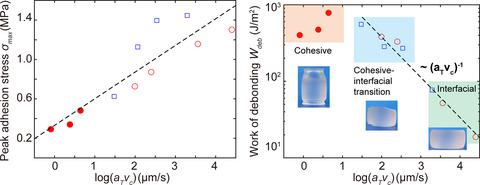当前位置:
X-MOL 学术
›
J. Am. Ceram. Soc.
›
论文详情
Our official English website, www.x-mol.net, welcomes your
feedback! (Note: you will need to create a separate account there.)
Temperature and rate dependent debonding behaviors of precision glass molding interface
Journal of the American Ceramic Society ( IF 3.5 ) Pub Date : 2020-09-21 , DOI: 10.1111/jace.17478 Jian Zhou 1 , Chenyu Zhu 1 , Lihua Li 2 , Man Cheung Ng 3 , Kun Liu 1
Journal of the American Ceramic Society ( IF 3.5 ) Pub Date : 2020-09-21 , DOI: 10.1111/jace.17478 Jian Zhou 1 , Chenyu Zhu 1 , Lihua Li 2 , Man Cheung Ng 3 , Kun Liu 1
Affiliation

|
The glass‐to‐mold adhesion in precision glass molding could severely degrade the quality of molded optics and shorten the lifespan of the precious molds. Since the consequences of adhesion take effect during the separation between glass and molds, it is important to investigate the debonding behaviors of a typical glass molding interface. To this end, here we perform a probe tack test procedure for borosilicate glass BK7, where debonding is conducted at molding temperature and specific velocity. We fully characterize the debonding behaviors using the peak adhesion stress σmax and the work of debonding Wdeb. Experiments show that when temperature is decreased from 690°C to 655°C at 10 μm/s, σmax continuously increases, while Wdeb first increases but then sharply decreases. When the debonding velocity is increased from 10 to 50 μm/s at 680°C, σmax also increases while Wdeb overall decreases. Therefore, the debonding behaviors are highly temperature and rate dependent. More importantly, depending on the debonding conditions, three debonding types are identified, that is, the cohesive bulk deformation, the cohesive‐interfacial transition and the interfacial fracture. The cohesive type can be converted into the interfacial fracture, by either decreasing temperature or increasing the debonding velocity. Based on the Wdeb criterion, the three debonding regimes can be clearly distinguished. Finally, analyses on the temperature and velocity experimental results are unified by incorporating the reduced crack velocity aTvc. The dependences of both viscoelasticity and Wdeb on aTvc qualitatively explain the transition condition for different debonding types. Concerning these findings, the work of debonding not only supplements the characterization of adhesion strength, but also throws insightful light on revealing the debonding mechanisms.
中文翻译:

取决于温度和速率的精密玻璃成型界面的剥离性能
精密玻璃成型中的玻璃与模具的粘合会严重降低成型光学器件的质量,并缩短贵重模具的使用寿命。由于粘附的后果是在玻璃和模具之间的分离过程中起作用的,因此研究典型的玻璃模制界面的脱粘行为非常重要。为此,在此我们对硼硅玻璃BK7进行探针粘结测试程序,其中脱胶是在成型温度和特定速度下进行的。我们完全表征利用峰值粘结力舒解行为σ最大和脱胶工作W¯¯ DEB。实验表明,当温度从690℃以10微米/秒,下降到655℃,σ最大连续增加,而W deb先增加,然后急剧减少。当松解速度从10提高到50微米/秒至680℃,σ最大也增加,而w ^ DEB整体减小。因此,脱粘行为高度依赖于温度和速率。更重要的是,根据脱胶条件,可以确定三种脱胶类型,即内聚体变形,内聚-界面转变和界面断裂。通过降低温度或提高剥离速度,可将内聚型转变为界面断裂。基于W deb根据标准,可以清楚地区分三种剥离方式。最后,结合降低的裂纹速度a T v c,对温度和速度实验结果的分析进行统一。既粘弹性和的依赖性W¯¯ DEB上一个Ť v ç定性解释为不同类型的脱粘的转移条件。关于这些发现,脱胶的工作不仅补充了粘合强度的特性,而且在揭示脱胶机理上也有深刻的见解。
更新日期:2020-11-22
中文翻译:

取决于温度和速率的精密玻璃成型界面的剥离性能
精密玻璃成型中的玻璃与模具的粘合会严重降低成型光学器件的质量,并缩短贵重模具的使用寿命。由于粘附的后果是在玻璃和模具之间的分离过程中起作用的,因此研究典型的玻璃模制界面的脱粘行为非常重要。为此,在此我们对硼硅玻璃BK7进行探针粘结测试程序,其中脱胶是在成型温度和特定速度下进行的。我们完全表征利用峰值粘结力舒解行为σ最大和脱胶工作W¯¯ DEB。实验表明,当温度从690℃以10微米/秒,下降到655℃,σ最大连续增加,而W deb先增加,然后急剧减少。当松解速度从10提高到50微米/秒至680℃,σ最大也增加,而w ^ DEB整体减小。因此,脱粘行为高度依赖于温度和速率。更重要的是,根据脱胶条件,可以确定三种脱胶类型,即内聚体变形,内聚-界面转变和界面断裂。通过降低温度或提高剥离速度,可将内聚型转变为界面断裂。基于W deb根据标准,可以清楚地区分三种剥离方式。最后,结合降低的裂纹速度a T v c,对温度和速度实验结果的分析进行统一。既粘弹性和的依赖性W¯¯ DEB上一个Ť v ç定性解释为不同类型的脱粘的转移条件。关于这些发现,脱胶的工作不仅补充了粘合强度的特性,而且在揭示脱胶机理上也有深刻的见解。











































 京公网安备 11010802027423号
京公网安备 11010802027423号